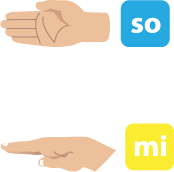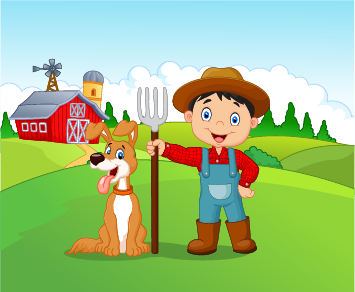
Level 1. Lesson 13. Present so & mi
![]()
![]() Woodblock
Woodblock
Difficulty: ![]()
Prior learning: High and low sounds
Prepare: Lines & spaces Present: so & mi Practice: ta & ti-ti

Curwen hand signs are a system developed by John Curwen to visually and kinesthetically represent solfège syllables (do, re, mi, fa, so, la, ti). Each hand sign corresponds to a pitch in the scale, making it easier for students to understand the relative positions of pitches.
For "Goodnight", the focus is on so and mi:
- so: The hand is at shoulder height, and the palm is facing downward. It represents a higher pitch in the pattern.
- mi: Hand is at chest height, palm facing downward. It represents a lower pitch.

![]() Students will learn to sing by echoing the teacher and practising line by line.
Students will learn to sing by echoing the teacher and practising line by line.
![]() Lyrics
Lyrics
Kangaroo, skippy roo
Dozing in the midday sun.
Comes a hunter, run, run, run.
Guess who's caught you, just for fun!
- Sing the song's first line clearly and ask students to echo it back.
- Continue with the next line, and have students echo back.
- Repeat this process for each song line until all lines are learned.
- Sing the entire song with the class, encouraging them to join in confidently.
- Repeat as necessary to ensure accuracy and fluency.
 Success Criteria
Success Criteria
- I can echo the teacher’s singing accurately.
- I can sing each line of the song confidently.
- I can sing the entire song with my classmates.
 Questions
Questions
- What was the kangaroo doing in the beginning?
- What time of day was it?
- Who caught the kangaroo?

![]() Students will discover and identify the pitches so and mi by exploring the melody of a known song and using hand signs.
Students will discover and identify the pitches so and mi by exploring the melody of a known song and using hand signs.
![]() Lyrics
Lyrics
Good night, sleep tight.
Friends will come tomorrow night.
 Questions
Questions
- What names do we give the high and low sounds in this song?
- Is so higher or lower than mi?
- Is the hand sign for so near the head or the tummy?
- Begin by singing the song to the class without naming the pitches.
- Ask the students to listen carefully and notice how the sounds move (e.g., “Does the music go up or down?”).
- Sing the first phrase of the song again, pausing to ask guiding questions: “Do you hear a high or a low sound at the start?”
- Ask, “What happens next? Does the sound go up or go down?”
- Encourage students to mimic the melody with their voices, focusing on whether they sing higher or lower pitches.
- Explain we can label high and low sounds with special names in this song. We call the high sound so and the low sound mi.”
- Demonstrate the first phrase of the song using so and mi, showing hand signs spatially with your whole arm (so high, mi lower).
- Sing the first phrase again using so and mi, and have students echo.
- Guide them to notice the pattern (e.g., “What do you notice about the sounds? Does so always come before mi?”).
- Sing the entire song using so and mi, using hand signs. Then, ask students to sing it with you.
- When secure, sing the song with lyrics, focusing on the so and mi hand signs.
- Ask students to identify where they hear so and mi in the song.
 Success Criteria
Success Criteria
- I can identify the high (so) and low (mi) sounds in the melody.
- I can sing the song using the solfège syllables so and mi.
- I can use hand signs to show the difference between so and mi.
![]() Students will develop their inner hearing (audiation) by chanting and marching to the beat.
Students will develop their inner hearing (audiation) by chanting and marching to the beat.
![]() Lyrics
Lyrics
Feet, feet, feet, feet
Going up and down the street.
Big feet, little feet,
Can't catch me!
 Questions
Questions
- Can big feet and little feet march to the same beat?
- Where are the feet going in the song?
- Can the feet be caught?
- Ask students to spread out in the room to ensure enough space to move and march.
- Lead the class in chanting "Feet Feet" while marching to the beat.
- Model steady, deliberate movements with your feet to establish a clear beat.
- Encourage students to focus on keeping their movements in time with the chant.
- After a repetition, pause and explain that we will put the words in our heads. You’ll still march to the beat but won’t say the words out loud. Instead, hear them silently in your head.
- Lead the students in silent marching, observing whether they maintain the beat.
- After a few measures, stop and ask: “Did you hear the chant in your head? Did your feet stay in time?”
- Alternate between chanting out loud and silent audiation to reinforce their ability to keep the beat internally.
- For example, chant aloud for four measures, then march silently for four measures.
- Gather the students and ask: “What was it like to keep the beat in your head?” and “Did you find it easier or harder to march without saying the words? Why?”
 Success Criteria
Success Criteria
- I can chant "Feet Feet" and keep the beat with my feet.
- I can march silently while keeping the beat in my head.
- I can maintain a steady beat even when the words are not spoken aloud.
![]() Students will learn to sing the song "Bingo," focusing on letter recognition, maintaining a steady beat, and coordinating clapping with singing.
Students will learn to sing the song "Bingo," focusing on letter recognition, maintaining a steady beat, and coordinating clapping with singing.
![]() Lyrics
Lyrics
There was a farmer had a dog and Bingo was his name, O
B I N GO, BINGO, BINGO,
and Bingo was his name -O!
- Write the letters B-I-N-G-O on the board for students to see.
- Sing the entire song to the class, clapping a steady beat as you sing.
- Encourage students to listen carefully to the rhythm, melody, and spelling of the name Bingo.
- Break the song into smaller parts: Start with “There was a farmer had a dog and Bingo was his name-o.” Have students echo this line back to you.
- Repeat for “B-I-N-G-O,” singing it three times with the final line, “And Bingo was his name-o.”
- Demonstrate clapping to a steady beat while singing the song.
- Have students clap along with you as you sing the first verse.
- Practise until they are comfortable coordinating clapping and singing.
- Point to the letters B-I-N-G-O on the board as you sing and clap.
- Encourage students to clap and sing simultaneously while spelling out B-I-N-G-O.
- Gradually replace the letters with claps:Sing: “B-I-N-G-O” but clap instead of singing B.
- Add more silent letters (e.g., clap for B and I) in subsequent rounds until all letters are replaced with clapping.
- Encourage students to keep the beat and remember the sequence of letters.
 Success Criteria
Success Criteria
- I can sing the song and spell the letters in the correct order.
- I can keep a steady beat while clapping in time with the song.
- I can replace letters with claps at the correct points in the song.
 Questions
Questions
- What other animals could the farmer have, and what names might they spell in a song?
- If Bingo could do tricks, what would he do when he heard his name in the song?
- How many times do we sing the letters B-I-N-G-O in the song? Can you count them all?

![]() Students will identify and perform the pitches so and mi with solfège and hand signs.
Students will identify and perform the pitches so and mi with solfège and hand signs.
![]() Lyrics
Lyrics
Bye lo, baby-o,
Off to dream land you must go.
 Questions
Questions
- Is so higher than mi?
- How many ta's in the song?
- Where must the baby go?
- Explain that in this song, so is the higher sound, and mi is the lower sound.
- Demonstrate the hand signs for so (shoulder height, palm down) and mi (chest height, palm down).
- Sing the first phrase using so and mi: so, mi, so, mi.
- Ask students to echo you while using the hand signs.
- Repeat for the second phrase.
- Sing the whole song together using solfège syllables and hand signs.
- Gradually transition to singing the lyrics while maintaining the hand signs for so and mi.
- Pair up students and have them lead each other in singing and performing the hand signs for so and mi.
 Success Criteria
Success Criteria
- I can sing using the solfège syllables so and mi.
- I can perform the correct hand signs for so and mi.
- I can recognise the pitch relationship between so and mi in the song.

![]() Students will identify songs by recognising and clapping rhythms, and practise performing rhythm syllables.
Students will identify songs by recognising and clapping rhythms, and practise performing rhythm syllables.
- Project the image of 'Find the song!' and clap the rhythm of the first.
- Then, speak the rhythm syllables.
- Invite students to tell you the name of the song.
- Repeat the process, and lead the class in singing the song.
- Ask a volunteer to come forward to speak the syllables while pointing to each in turn.
- Ask the class how they think the student performed using thumbs up, down or in the middle.
- Repeat the process with another student.
- Using the second image, repeat the process above.
 Success Criteria
Success Criteria
- I can identify a song by its rhythm.
- I can clap and speak the rhythm syllables accurately.
- I can assess my peers’ performances using constructive feedback.
 Questions
Questions
- How many beats are in the first song? [8]
- How many are in the scone song? [8]
- How many times does ta appear in the first song [5]
![]() ASSESSMENT QUESTIONS
ASSESSMENT QUESTIONS
- The student can demonstrate the hand signs for so and mi.
- The student can clap the beat and accurately spell the letters while singing the song Bingo.
- The student can maintain the beat silently through inner hearing after transitioning from chanting Feet, Feet.

Suggested lessons
Y1. Beat II

Y1. Beat III

Y1. Beat IV

